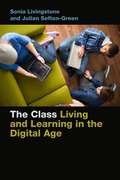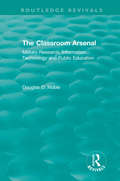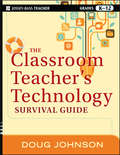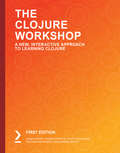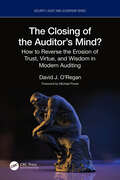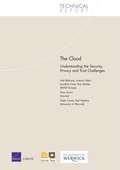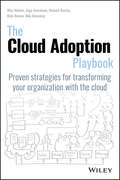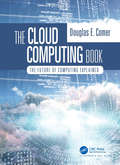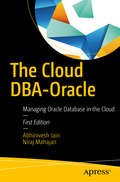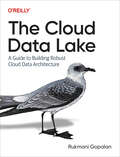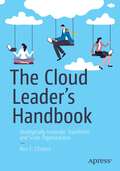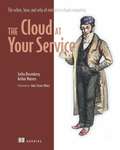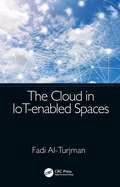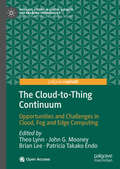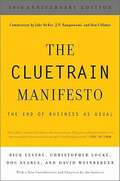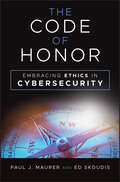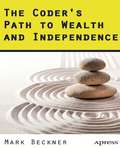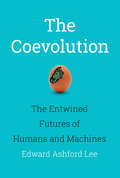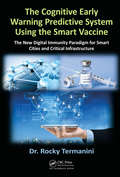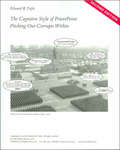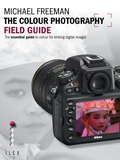- Table View
- List View
The Class: Living and Learning in the Digital Age (Connected Youth and Digital Futures #1)
by Sonia Livingstone Julian Sefton-GreenAn intimate look at how children network, identify, learn and grow in a connected world.Read Online at connectedyouth.nyupress.orgDo today’s youth have more opportunities than their parents? As they build their own social and digital networks, does that offer new routes to learning and friendship? How do they navigate the meaning of education in a digitally connected but fiercely competitive, highly individualized world?Based upon fieldwork at an ordinary London school, The Class examines young people's experiences of growing up and learning in a digital world. In this original and engaging study, Livingstone and Sefton-Green explore youth values, teenagers’ perspectives on their futures, and their tactics for facing the opportunities and challenges that lie ahead. The authors follow the students as they move across their different social worlds—in school, at home, and with their friends, engaging in a range of activities from video games to drama clubs and music lessons. By portraying the texture of the students’ everyday lives, The Class seeks to understand how the structures of social class and cultural capital shape the development of personal interests, relationships and autonomy. Providing insights into how young people’s social, digital, and learning networks enable or disempower them, Livingstone and Sefton-Green reveal that the experience of disconnections and blocked pathways is often more common than that of connections and new opportunities.
The Classroom Arsenal: Military Research, Information Technology and Public Education (Routledge Revivals)
by Douglas D. NobleA quarter of a century after its initial publication, The Classroom Arsenal remains pivotal in understanding and challenging the relentless promotion of technology to reform education. This seemingly benign education technology juggernaut carries forward the momentum of military agendas in man-machine systems detailed in the book. Promoters continue to flood schools with technology and its (still unfulfilled) promise of cutting edge, "personalized learning." Meanwhile, they continue as well their insatiable pursuit of federal funding, educational legitimacy, corporate profits, and access to student subjects and their accumulated learning data for product development. Less understood, though, is a companion enterprise, there from the start, to replace teaching and learning in traditional classrooms by efficient automated systems that manage and monitor human cognition and learning for high-performance systems, from weapons systems to high tech corporations. As education is moved imperceptibly away from its traditional humanistic aims and from the classroom itself, the goal of this human engineering project, the depersonalized accumulation of cognitive components for a 21st century militarized economy, best befits the book’s original title: "The Human Arsenal." This ongoing military/corporate-sponsored enterprise continues to impact education today, largely unnoticed. One example is the federally-funded Advanced Distributed Learning Initiative (ADL), which has been a major force behind the implementation of electronic learning systems, now used in all Defense Department and federal employee training. With the Defense Advanced Research Project Agency (ARPA) ADL is developing structures to capture students’ soft skills, and the Army Research Laboratory is developing "intelligent tutoring systems" to enable "instructional management of affect, engagement, and grit (perseverance)." ADL through the Department of Defense has developed Experience API, a learning technology that can monitor all student online and offline interactions and archive these in date lockers or learning record stores. ADL has already impacted thousands of school districts through nonprofits such as IMS Global and Future Ready Schools, part of an industry massively subsidized by high tech corporations and valued at $255 billion annually. A $90 million Advanced Research Projects Agency for Education (ARPA-ED), modeled after the military’s ARPA, has been proposed to fund "dramatic breakthroughs in learning and teaching." These include "digital tutors as effective as personal tutors" and, with the Navy’s Full Spectrum Learning project, "data collection tools for personalized education modeled after corporate data analysis that identifies consumer patterns and preferences." ADL is just one example of how the military/corporate ed tech enterprise is changing public education by hollowing it out into something that can be digitized, data-driven, automated, and monitored. Its promoters envision education as children interacting with online learning systems where, based on past performance, algorithms will serve up what each student needs to know next. Through this digital curriculum, students create virtual educational identities at very young ages and learning devices are watching students as much as students are watching them. Such is the education landscape presaged by The Classroom Arsenal a quarter century ago, whose origins and trajectories need to be deeply understood now more than ever.
The Classroom Teacher'S Technology Survival Guide
by Doug JohnsonA comprehensive guide for integrating educational technology in the K-12 classroom This is a must-have resource for all K-12 teachers and administrators who want to really make the best use of available technologies. Written by Doug Johnson, an expert in educational technology, The Classroom Teacher's Technology Survival Guide is replete with practical tips teachers can easily use to engage their students and make their classrooms places where both students and teachers will enjoy learning. Covers the most up-to-date technologies and how they can best be used in the classroom Includes advice on upgrading time-tested educational strategies using technology Talks about managing "disruptive technologies" in the classroom Includes a wealth of illustrative examples, helpful suggestions, and practical tips This timely book provides a commonsense approach to choosing and using educational technology to enhance learning.
The Climate Intelligent Organization: Build a Prosperous and Resilient Future for the Planet Through AI-Powered Climate Intelligence
by Iggy Bassi Karan ChopraLearn to make sound business decisions on a rapidly changing planet In The Climate Intelligent Organization, renowned entrepreneurs and climate intelligence pioneers Iggy Bassi and Karan Chopra, deliver an intuitive and practical guide to the transformative power of AI-driven Unified Climate Intelligence (UCI). Written with the business practitioner in mind, the book showcases how holistic climate analysis can be integrated into decisions, growth plans, and investments as organizations navigate the challenges and opportunities of climate change. You'll discover: How UCI can redefine competitive advantage and reshape leadership. Strategies to improve climate-related financial performance. A roadmap for driving resilient value creation in the new climate economy. Perfect for managers, executives, directors, policy makers, entrepreneurs, founders, and other business leaders, The Climate Intelligent Organization will also prove invaluable to finance and sustainability professionals seeking new insights into how to adapt to a changing planet.
The Clojure Workshop: A New, Interactive Approach to Learning Clojure
by Konrad Szydlo Joseph Fahey Thomas Haratyk Scott McCaughie Yehonathan SharvitCut through the noise and get real results with a step-by-step approach to learning Clojure programming Key Features Ideal for the Clojure beginner who is getting started for the first time A step-by-step Clojure tutorial with exercises and activities that help build key skills Structured to let you progress at your own pace, on your own terms Use your physical print copy to redeem free access to the online interactive edition Book Description You already know you want to learn Clojure, and a smarter way to learn Clojure is to learn by doing. The Clojure Workshop focuses on building up your practical skills so that you can write clean, expressive code with a language that is great for applications where concurrency and interoperability with the JVM are a priority. You'll learn from real examples that lead to real results. Throughout The Clojure Workshop, you'll take an engaging step-by-step approach to understanding Clojure. You won't have to sit through any unnecessary theory. If you're short on time you can jump into a single exercise each day or spend an entire weekend learning about Clojure web development with Ring. It's your choice. Learning on your terms, you'll build up and reinforce key skills in a way that feels rewarding. Every physical print copy of The Clojure Workshop unlocks access to the interactive edition. With videos detailing all exercises and activities, you'll always have a guided solution. You can also benchmark yourself against assessments, track progress, and receive content updates. You'll even earn a secure credential that you can share and verify online upon completion. It's a premium learning experience that's included with your printed copy. To redeem, follow the instructions located at the start of your Clojure book. Fast-paced and direct, The Clojure Workshop is the ideal for Clojure beginners. You'll build and iterate on your code like a software developer , learning along the way. This process means that you'll find that your new skills stick, embedded as best practice. A solid foundation for the years ahead. What you will learn Learn about Clojure fundamentals like functional programming Understand and implement common Clojure patterns and best practices Explore Clojure's testing infrastructure and the clojure.test library Build a client-server application with Clojure and ClojureScript Learn how to debug and resolve errors and exceptions Explore Ring – Clojure's interface and library for building web applications Who this book is for Our goal at Packt is to help you be successful, in whatever it is you choose to do. The Clojure Workshop is an ideal Clojure tutorial for the Clojure beginner who is just getting started. Pick up a Workshop today, and let Packt help you develop skills that stick with you for life.
The Closing of the Auditor’s Mind?: How to Reverse the Erosion of Trust, Virtue, and Wisdom in Modern Auditing (Security, Audit and Leadership Series)
by David J. O'ReganIn The Closing of the Auditor’s Mind?, author David J. O’Regan describes internal auditing as an important "binding agent" of social cohesion, for the accountability of individuals and organizations and also at aggregated levels of social trust. However, O’Regan also reveals that internal auditing faces two severe challenges – an external challenge of adaptation and an internal challenge of fundamental reform.The adaptation challenge arises from ongoing, paradigmatic shifts in accountability and social trust. The command- and- control, vertical hierarchies of traditional bureaucracies are being replaced in importance by networked, flattened patterns of accountability. The most challenging assurance demands of the modern era are increasingly located in three institutional domains – in the inner workings of organizations; in intermediary spaces at organizational boundaries; and in extra-mural locations. Internal auditing continues to cling, barnacle- like, to the inner workings of traditional, bureaucratic structures, and it has little to offer the emerging assurance demands on or beyond institutional boundaries. The reform challenge arises from internal auditing’s prevailing tendency toward a rigid, algorithmic, checklist mindset that suppresses practitioners’ creativity and critical thinking. This trend is increasingly narrowing internal auditing’s intellectual and moral horizons. Under the pressures of these challenges, internal auditing is struggling to fulfil its primary purpose of serving the public interest.O’Regan’s powerful book focuses on: The redistribution of social trust from traditional, hierarchical institutions to diffuse, horizontally distributed networks The perennial validity of the classical virtues as the humane foundation of professional activity The role of creative expertise in promoting professional wisdom The Closing of the Auditor’s Mind? is a philosophical audit of a profession on the threshold of crisis. The book presupposes no prior knowledge of philosophy, nor indeed of auditing. Philosophical technicalities are contained in an Appendix, leaving the main text jargon-free. O’Regan provides original and striking perspectives on the malaise of modern internal auditing, and he proposes radical remedies. This captivating and well-informed book is a must-read for all who are concerned with our collective socio-economic and political well-being.
The Cloud
by Tony Starkey Neil Robinson Hans Graux Lorenzo Valeri Jonathan CaveThis report discusses how policy-makers might address the challenges and risks in respect of the security, privacy and trust aspects of cloud computing that could undermine the attainment of broader economic and societal objectives across Europe.
The Cloud Adoption Playbook: Proven Strategies for Transforming Your Organization with the Cloud
by Moe Abdula Ingo Averdunk Roland Barcia Kyle Brown Ndu EmuchayThe essential roadmaps for enterprise cloud adoption As cloud technologies continue to challenge the fundamental understanding of how businesses work, smart companies are moving quickly to adapt to a changing set of rules. Adopting the cloud requires a clear roadmap backed by use cases, grounded in practical real-world experience, to show the routes to successful adoption. The Cloud Adoption Playbook helps business and technology leaders in enterprise organizations sort through the options and make the best choices for accelerating cloud adoption and digital transformation. Written by a team of IBM technical executives with a wealth of real-world client experience, this book cuts through the hype, answers your questions, and helps you tailor your cloud adoption and digital transformation journey to the needs of your organization. This book will help you: Discover how the cloud can fulfill major business needs Adopt a standardized Cloud Adoption Framework and understand the key dimensions of cloud adoption and digital transformation Learn how cloud adoption impacts culture, architecture, security, and more Understand the roles of governance, methodology, and how the cloud impacts key players in your organization. Providing a collection of winning plays, championship advice, and real-world examples of successful adoption, this playbook is your ultimate resource for making the cloud work. There has never been a better time to adopt the cloud. Cloud solutions are more numerous and accessible than ever before, and evolving technology is making the cloud more reliable, more secure, and more necessary than ever before. Don’t let your organization be left behind! The Cloud Adoption Playbook gives you the essential guidance you need to make the smart choices that reduce your organizational risk and accelerate your cloud adoption and digital transformation.
The Cloud Computing Book: The Future of Computing Explained
by Douglas ComerThis latest textbook from bestselling author, Douglas E. Comer, is a class-tested book providing a comprehensive introduction to cloud computing. Focusing on concepts and principles, rather than commercial offerings by cloud providers and vendors, The Cloud Computing Book: The Future of Computing Explained gives readers a complete picture of the advantages and growth of cloud computing, cloud infrastructure, virtualization, automation and orchestration, and cloud-native software design.The book explains real and virtual data center facilities, including computation (e.g., servers, hypervisors, Virtual Machines, and containers), networks (e.g., leaf-spine architecture, VLANs, and VxLAN), and storage mechanisms (e.g., SAN, NAS, and object storage). Chapters on automation and orchestration cover the conceptual organization of systems that automate software deployment and scaling. Chapters on cloud-native software cover parallelism, microservices, MapReduce, controller-based designs, and serverless computing. Although it focuses on concepts and principles, the book uses popular technologies in examples, including Docker containers and Kubernetes. Final chapters explain security in a cloud environment and the use of models to help control the complexity involved in designing software for the cloud.The text is suitable for a one-semester course for software engineers who want to understand cloud, and for IT managers moving an organization’s computing to the cloud.
The Cloud DBA-Oracle
by Abhinivesh Jain Niraj MahajanLearn how to define strategies for cloud adoption of your Oracle database landscape. Understand private cloud, public cloud, and hybrid cloud computing in order to successfully design and manage databases in the cloud. The Cloud DBA-Oracle provides an overview of Database-as-a-Service (DBaaS) that you can use in defining your cloud adoption strategy. In-depth details of various cloud service providers for Oracle database are given, including Oracle Cloud and Amazon Web Services (AWS). Database administration techniques relevant to hosting databases in the cloud are shown in the book as well as the technical details needed to perform all database administration tasks and activities, such as migration to the cloud, backup in the cloud, and new database setup in the cloud. You will learn from real-world business cases and practical examples of administration of Oracle database in the cloud, highlighting the challenges faced and solutions implemented. What you will learn: Cloud computing concepts from the DBA perspective, such as private cloud, public cloud, hybrid cloud Technical details of all aspects of cloud database administration Challenges faced during setup of databases in private cloud or database migration to public cloud Key points to be kept in mind during database administration in the cloud Practical examples of successful Oracle database cloud migration and support Who Is This Book For All levels of IT professionals, from executives responsible for determining database strategies to database administrators and database architects who manage and design databases.
The Cloud Data Lake: A Guide to Building Robust Cloud Data Architecture
by Rukmani GopalanMore organizations than ever understand the importance of data lake architectures for deriving value from their data. Building a robust, scalable, and performant data lake remains a complex proposition, however, with a buffet of tools and options that need to work together to provide a seamless end-to-end pipeline from data to insights.This book provides a concise yet comprehensive overview on the setup, management, and governance of a cloud data lake. Author Rukmani Gopalan, a product management leader and data enthusiast, guides data architects and engineers through the major aspects of working with a cloud data lake, from design considerations and best practices to data format optimizations, performance optimization, cost management, and governance.Learn the benefits of a cloud-based big data strategy for your organizationGet guidance and best practices for designing performant and scalable data lakesExamine architecture and design choices, and data governance principles and strategiesBuild a data strategy that scales as your organizational and business needs increaseImplement a scalable data lake in the cloudUse cloud-based advanced analytics to gain more value from your data
The Cloud Leader’s Handbook: Strategically Innovate, Transform, and Scale Organizations
by Ron C. L'EsteveThis book is a comprehensive guide covering modern cloud strategies and leadership approaches for building and scaling organizations to maturity on their cloud adoption journey. The book starts by examining technical topics from the perspective of the cloud leader, who is responsible for cloud teams and accountable for cloud products and platforms within their organization. Through a series of practical insights and real-world examples, you will gain a deep understanding of the key considerations for leading a cloud-driven organization. These considerations include understanding the benefits of digital transformation, managing global tech teams, and delivering excellence through platform ownership. Towards the end of the book, you will explore the latest trends and best practices for strategically innovating and scaling your organization in the cloud. With the knowledge gained from this book, you will be able to harness the power of the cloud to drive business success and gain valuable insights and practical strategies to support and empower the adoption of modern cloud platforms and technologies for your clients and organization. The Cloud Leader's Handbook is a must-read for any Cloud Leader who wants to stay ahead of the curve and achieve success in the rapidly evolving world of cloud computing. What Will You LearnDevelop a strong foundation in the technical aspects of cloud leadershipUnderstand the benefits of digital transformation and how to lead a cloud-driven organization, including managing global tech teams.Discover the bleeding-edge cloud trends that are influencing organizational roadmapsTransition into the role of the modern Cloud Leader by gaining a deeper perspective around what it means to own, manage, administer, govern, and optimize the modern cloud platformLearn how to effectively envision, manage, and deploy modern cloud transformation projects through successful approaches around innovation, strategy, and excellence Who This Book Is ForExperienced IT professionals and business leaders looking to understand the power of the cloud.
The Cloud at Your Service: The when, how, and why of enterprise cloud computing
by Jonathan Rosenberg Arthur MateosCloud Computing is here to stay. As an economically viable way for businesses of all sizes to distribute computing, this technology shows tremendous promise. But the intense hype surrounding the Cloud is making it next to impossible for responsible IT managers and businessdecision-makers to get a clear understanding of what the Cloud really means, what it might do for them, when it is practical, and what their future with the Cloud looks like.The Cloud at Your Service helps cut through all this fog to help enterprises make these critical decisions based on facts and the authors' informed unbiased recommendations and predictions. Purchase of the print book comes with an offer of a free PDF, ePub, and Kindle eBook from Manning. Also available is all code from the book.
The Cloud in IoT-enabled Spaces
by Fadi Al-TurjmanThe Cloud in IoT-enabled Spaces addresses major issues and challenges in IoT-based solutions proposed for the Cloud. It paves the way for IoT-enabled spaces in the next generation cloud computing paradigm and opens the door for further innovative ideas. Topics include Cloud-based optimization in the IoT era, scheduling and routing, medium access, data caching, secure access, uncertainty, home automation, machine learning in wearable devices, energy monitoring, and plant phenotyping in farming. Smart spaces are solutions where Internet of Things (IoT)-enabling technologies have been employed towards further advances in the lifestyle. It tightly integrates with the existing Cloud infrastructure to impact several fields in academia and industry. The Cloud in IoT-enabled Spaces provides an overview of the issues around small spaces and proposes the most up-to-date alternatives and solutions. The objective is to pave the way for IoT-enabled spaces in the next-generation Cloud computing and open the door for further innovative ideas.
The Cloud-to-Thing Continuum: Opportunities and Challenges in Cloud, Fog and Edge Computing (Palgrave Studies in Digital Business & Enabling Technologies)
by Theo Lynn Brian Lee John G. Mooney Patricia Takako EndoThe Internet of Things offers massive societal and economic opportunities while at the same time significant challenges, not least the delivery and management of the technical infrastructure underpinning it, the deluge of data generated from it, ensuring privacy and security, and capturing value from it.This Open Access Pivot explores these challenges, presenting the state of the art and future directions for research but also frameworks for making sense of this complex area. This book provides a variety of perspectives on how technology innovations such as fog, edge and dew computing, 5G networks, and distributed intelligence are making us rethink conventional cloud computing to support the Internet of Things. Much of this book focuses on technical aspects of the Internet of Things, however, clear methodologies for mapping the business value of the Internet of Things are still missing. We provide a value mapping framework for the Internet of Things to address this gap. While there is much hype about theInternet of Things, we have yet to reach the tipping point. As such, this book provides a timely entrée for higher education educators, researchers and students, industry and policy makers on the technologies that promise to reshape how society interacts and operates.
The Cluetrain Manifesto: The End of Business as Usual
by David Weinberger Christopher Locke Fredrick Levine David SearlsThe book provides a contrast in business and brand promotions from conventional methods to the internet age, where the conversations of connectedness have changed both the business we do, and the way its done.
The Cobra Event: A Novel
by Richard PrestonA deadly virus - and a desperate race against time.'One of the most horrifying things I've ever read in my entire life' Stephen KingOne spring morning in New York City a seventeen-year-old student wakes up feeling vaguely ill. Hours later she is having violent seizures, blood is pouring out of her nose, and she begins to attack her own body in the most hideous way imaginable. Soon, other gruesome deaths of a similar nature have been discovered, and the autopsies reveal that a previously unknown virus is at large. It replicates horribly fast, it is always fatal - and is just too efficient to be entirely natural.When the Centre for Disease Control sends a forensic pathologist to investigate, her discoveries precipitate a national crisis.THE COBRA EVENT is a dramatic, heart-stopping thriller of an all-too-real threat.
The Code Book: How to Make it, Break it, Hack it, Crack it
by Simon SinghIt's known as the science of secrecy. Cryptography: the encoding and de coding of private information. And it is history's most fascinating story of intrigue and cunning. The battle between codemakers and codebreakers has been going on for centuries: from Julius Caesar and his Caesar cipher to the codebreaking achievements of the tenth-century Arabs; from the code used by Mary Queen of Scots in an attempt to dethrone Elizabeth I to Sir Francis Walsingham's decipherment of that code, which led to Mary's execution for treason; from the Germans' use of the Enigma machine for automatic encryption in the Second World War to Alan Turing's efforts to infiltrate Enigma, which contributed to the Allied victory. And the battle rages on. How private are your e-mail communications? How secure is sending your credit card information over the Internet? And how much secrecy will the government tolerate? Simon Singh follows the evolution of secret writing with a clarity that lets the reader enjoy the captivating story while easily absorbing the details of cryptography. Woven throughout are clear and concise illustrations of the processes of enciphering and deciphering. Accessible, compelling and timely, this international bestseller, now adapted for young people, is sure to make readers see the past- and the future-in a whole new way.
The Code of Honor: Embracing Ethics in Cybersecurity
by Paul J. Maurer Ed SkoudisA comprehensive and practical framework for ethical practices in contemporary cybersecurity While some professions – including medicine, law, and engineering – have wholeheartedly embraced wide-ranging codes of ethics and conduct, the field of cybersecurity continues to lack an overarching ethical standard. This vacuum constitutes a significant threat to the safety of consumers and businesses around the world, slows commerce, and delays innovation. The Code of Honor: Embracing Ethics in Cybersecurity delivers a first of its kind comprehensive discussion of the ethical challenges that face contemporary information security workers, managers, and executives. Authors Ed Skoudis, President of the SANS Technology Institute College and founder of the Counter Hack team, and Dr. Paul Maurer, President of Montreat College, explain how timeless ethical wisdom gives birth to the Cybersecurity Code which is currently being adopted by security practitioners and leaders around the world. This practical book tells numerous engaging stories that highlight ethically complex situations many cybersecurity and tech professionals commonly encounter. It also contains compelling real-world case studies – called Critical Applications – at the end of each chapter that help the reader determine how to apply the hands-on skills described in the book. You'll also find: A complete system of cybersecurity ethics relevant to C-suite leaders and executives, front-line cybersecurity practitioners, and students preparing for careers in cybersecurity. Carefully crafted frameworks for ethical decision-making in cybersecurity. Timeless principles based on those adopted in countless professions, creeds, and civilizations. Perfect for security leaders, operations center analysts, incident responders, threat hunters, forensics personnel, and penetration testers, The Code of Honor is an up-to-date and engaging read about the ethically challenging world of modern cybersecurity that will earn a place in the libraries of aspiring and practicing professionals and leaders who deal with tech every day.
The Coder's Path to Wealth and Independence
by Mark BecknerDevelopers, programmers, technical architects, and consultants: You are highly skilled and have deep commitment to your craft as well as the motivation to excel. It's time to step away from the perceived security of a full-time salaried position, or a marginally successful solo business, and step into a world of freedom, independence, and wealth. With your current technical skills, and an open mind, you can rapidly build a highly successful and ethical business--and on your own terms. The Coder's Path to Wealth and Independence explains how. Mark Beckner, himself, a highly successful itinerant developer, shows you how to transform yourself from a skilled programmer into a highly creative and effective businessperson leveraging the skills you already have. You will learn to create opportunities where none have existed, create value for yourself and those you work with, substantially increase your income, define your ideals, and realize your dreams. By utilizing the unique strategies outlined in The Coder's Path to Wealth and Independence to build your practice, you will find your path to personal, professional, and financial prosperity. The Coder's Path to Wealth and Independence will show you how to: Work from wherever you want Use your technical skills to create a high-revenue, highly independent business Learn the skills of the "rainmaker" to acquire new projects and clients Operate under various fee models, allowing you to increase your wealth and your freedom Rapidly create proposals and contracts Manage projects and execute on your goals with greater skill than ever In short, this book will help you discover a variety of powerful and unique approaches to business that will allow you be highly successful--where, how, and whenever you want. What you'll learn How to take your technical skills and create a high revenue, highly independent business based on them How to work from wherever you want, and stay in constant motion, on your terms How to create opportunities through unique approaches to client acquisition and advertising How to focus on self-mastery and discipline in order to create a thriving practice How to implement a powerful business model, tailored to solo developers and technical consultants, that enables you to work when, where, and how you want Who this book is for Coders, architects, and technical consultants, and anyone in the world of technology all have the core skills required to follow this path to freedom and riches. This is a guide targeted at people who want to create and grow thriving and rewarding solo, technically focused practices. Table of Contents Chapter 1: Travel: The Power of Staying in Motion Chapter 2: Skills: The Nature of Programming and Business Chapter 3: Discipline and Education: The Importance of Continuous Improvement Chapter 4: Ethics: The Foundation of Relationships and Business Chapter 5: Structuring Your Business: Protecting Yourself Chapter 6: Advertising and Marketing: The Science of Lead Creation Chapter 7: Prospecting and Sales: The Art of Rainmaking Chapter 8: Proposals and Contracts: Trust, Flexibility and Simplicity Chapter 9: Fees and Income: Creating a High Dollar Revenue Stream Chapter 10: Goal Setting: The Engine Behind Your Success Chapter 11: Growth and Expansion: Handling Success Chapter 12: Investing in Your Business and Utilizing Wealth: The Abundance Mentality Chapter 13: Health: Personal Vitality and the Impact on Your Business Chapter 14: Freedom through Business: Wealth, Dreams, and Independence
The Coevolution: The Entwined Futures of Humans and Machines (The\mit Press Ser.)
by Edward Ashford LeeShould digital technology be viewed as a new life form, sharing our ecosystem and coevolving with us?Are humans defining technology, or is technology defining humans? In this book, Edward Ashford Lee considers the case that we are less in control of the trajectory of technology than we think. It shapes us as much as we shape it, and it may be more defensible to think of technology as the result of a Darwinian coevolution than the result of top-down intelligent design. Richard Dawkins famously said that a chicken is an egg's way of making another egg. Is a human a computer's way of making another computer? To understand this question requires a deep dive into how evolution works, how humans are different from computers, and how the way technology develops resembles the emergence of a new life form on our planet.Lee presents the case for considering digital beings to be living, then offers counterarguments. What we humans do with our minds is more than computation, and what digital systems do—be teleported at the speed of light, backed up, and restored—may never be possible for humans. To believe that we are simply computations, he argues, is a “dataist” faith and scientifically indefensible. Digital beings depend on humans—and humans depend on digital beings. More likely than a planetary wipe-out of humanity is an ongoing, symbiotic coevolution of culture and technology.
The Cognitive Early Warning Predictive System Using the Smart Vaccine: The New Digital Immunity Paradigm for Smart Cities and Critical Infrastructure
by Rocky TermaniniThis book introduces the Cognitive Early Warning Predictive System (CEWPS ) as the new digital immune system. Similar to the human immune system, CEWPS relies on true or "inoculated" sickness experience to defend the body. The book also introduces The Smart Vaccine an intelligent agent that manages all the vaccination-as-a-service on the cloud before an attack happens. The book illustrates the current landscape of cyber warfare, highlights the vulnerabilities of critical infrastructure, and identifies the shortcomings of AVT. Next, it describes the concept, the architecture, and the enabling technologies required to build a digital immune system.
The Cognitive Style Of PowerPoint: Pitching Out Corrupts Within
by Edward TufteIn corporate and government bureaucracies, the standard method for making a presentation is to talk about a list of points organized onto slides projected up on the wall. For many years, overhead projectors lit up transparencies, and slide projectors showed high-resolution 35mm slides. Now 'slideware' computer programs for presentations are nearly everywhere. Early in the 21st century, several hundred million copies of Microsoft PowerPoint were turning out trillions of slides each year. Unfortunately, slideware often reduces the analytical quality of presentations. In particular, the popular PowerPoint templates (ready-made designs) usually weaken verbal and spatial reasoning, and almost always corrupt statistical analysis. The author examines how these problems can be avoided and how to improve Powerpoint (and other) presentations.
The Cold Start Problem: How to Start and Scale Network Effects
by Andrew ChenA startup executive and investor draws on expertise developed at the premier venture capital firm Andreessen Horowitz and as an executive at Uber to address how tech’s most successful products have solved the dreaded "cold start problem”—by leveraging network effects to launch and scale toward billions of users.Although software has become easier to build, launching and scaling new products and services remains difficult. Startups face daunting challenges entering the technology ecosystem, including stiff competition, copycats, and ineffective marketing channels. Teams launching new products must consider the advantages of “the network effect,” where a product or service’s value increases as more users engage with it. Apple, Google, Microsoft, and other tech giants utilize network effects, and most tech products incorporate them, whether they’re messaging apps, workplace collaboration tools, or marketplaces. Network effects provide a path for fledgling products to break through, attracting new users through viral growth and word of mouth.Yet most entrepreneurs lack the vocabulary and context to describe them—much less understand the fundamental principles that drive the effect. What exactly are network effects? How do teams create and build them into their products? How do products compete in a market where every player has them? Andrew Chen draws on his experience and on interviews with the CEOs and founding teams of LinkedIn, Twitch, Zoom, Dropbox, Tinder, Uber, Airbnb, and Pinterest to offer unique insights in answering these questions. Chen also provides practical frameworks and principles that can be applied across products and industries. The Cold Start Problem reveals what makes winning networks thrive, why some startups fail to successfully scale, and, most crucially, why products that create and compete using the network effect are vitally important today.
The Colour Photography Field Guide: The Essential Guide to Hue for Striking Digital Images (Field Guide Ser.)
by Michael FreemanUnderstand the role colour plays in your images, learn to appreciate its dynamic effects and find out how to capture and reproduce it as precisely as possible in your own images.The Colour Photography Field Guide provides a unique look at analysing and combining three important ways of dealing with colour. The first is the subjective and cultural response to individual colour: the perception. The second is how colours are found and appear in photography: the science. The third is the means by which they can be viewed and altered digitally: the expression.- A clear and technically precise look at how colour affects your digital images- Portable and lightweight, for on-the-spot information and inspiration- With a host of case studies examining difficult colour situations such as capturing flesh tones and unreal colours
